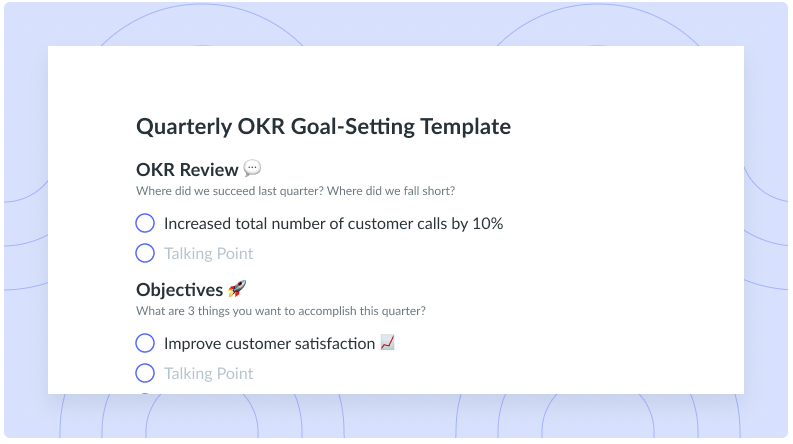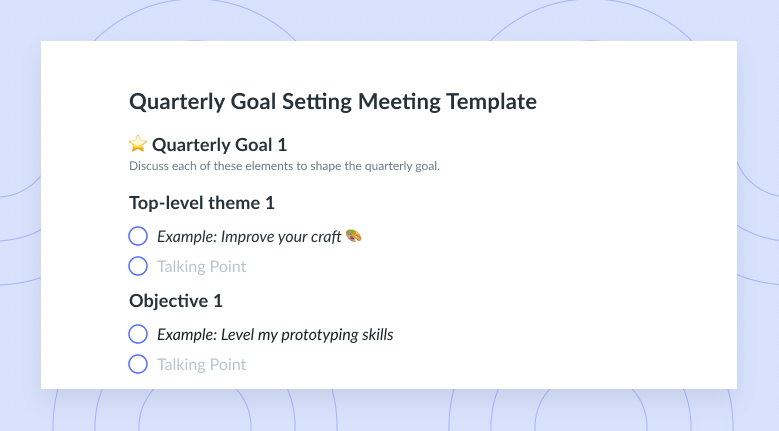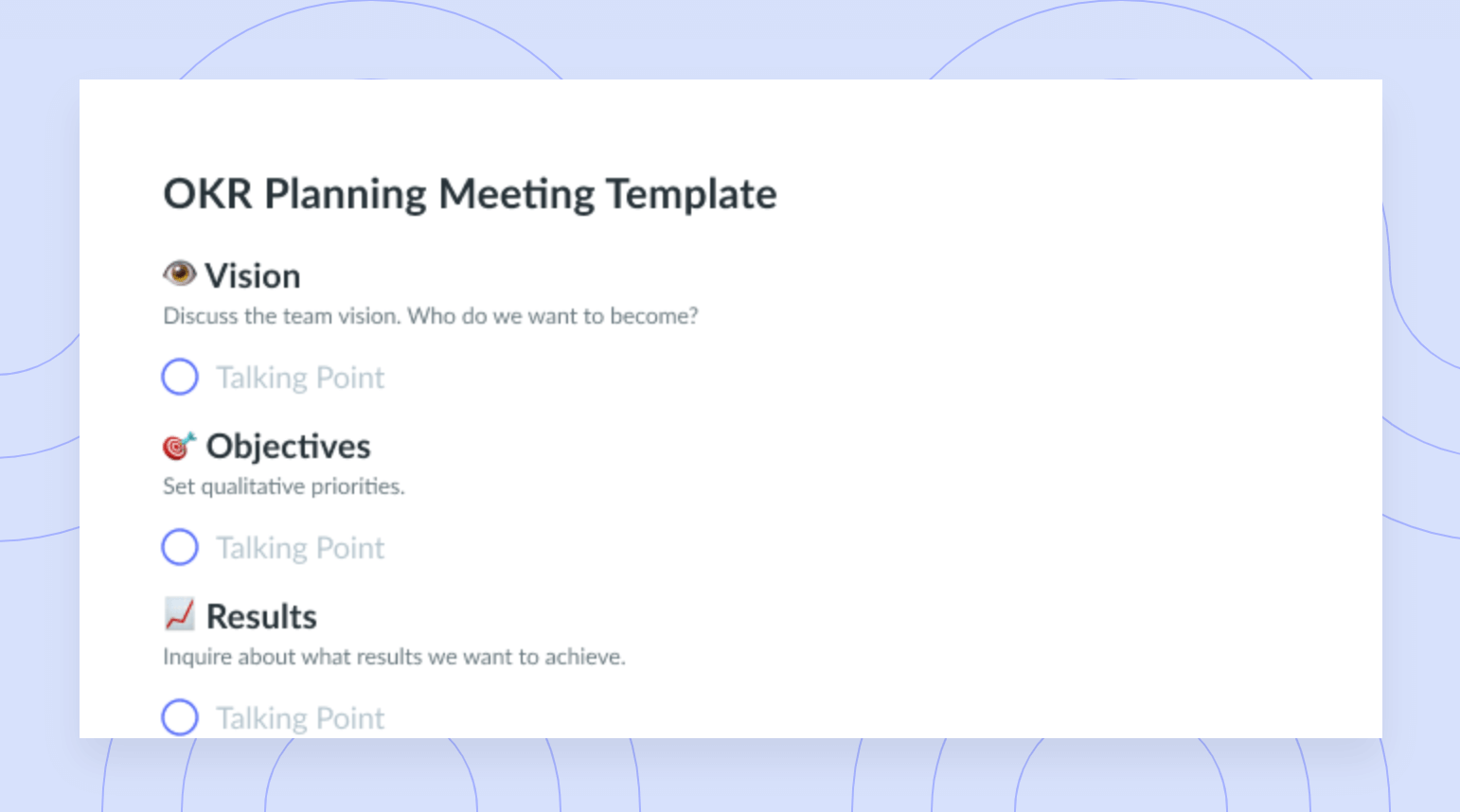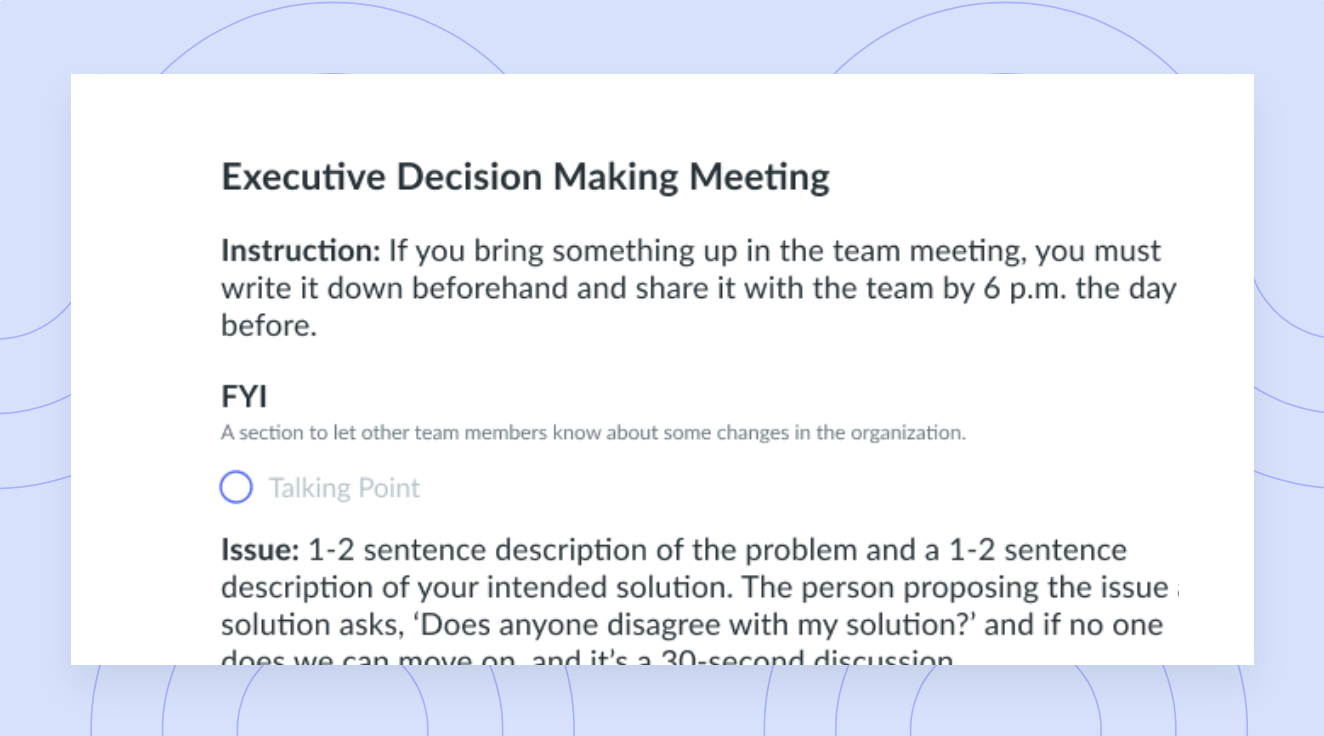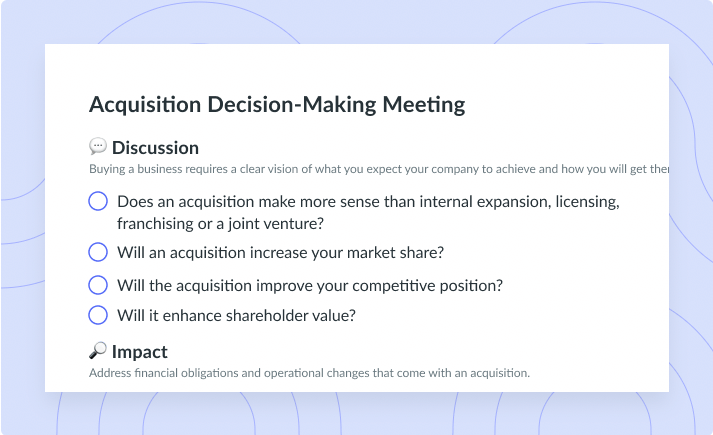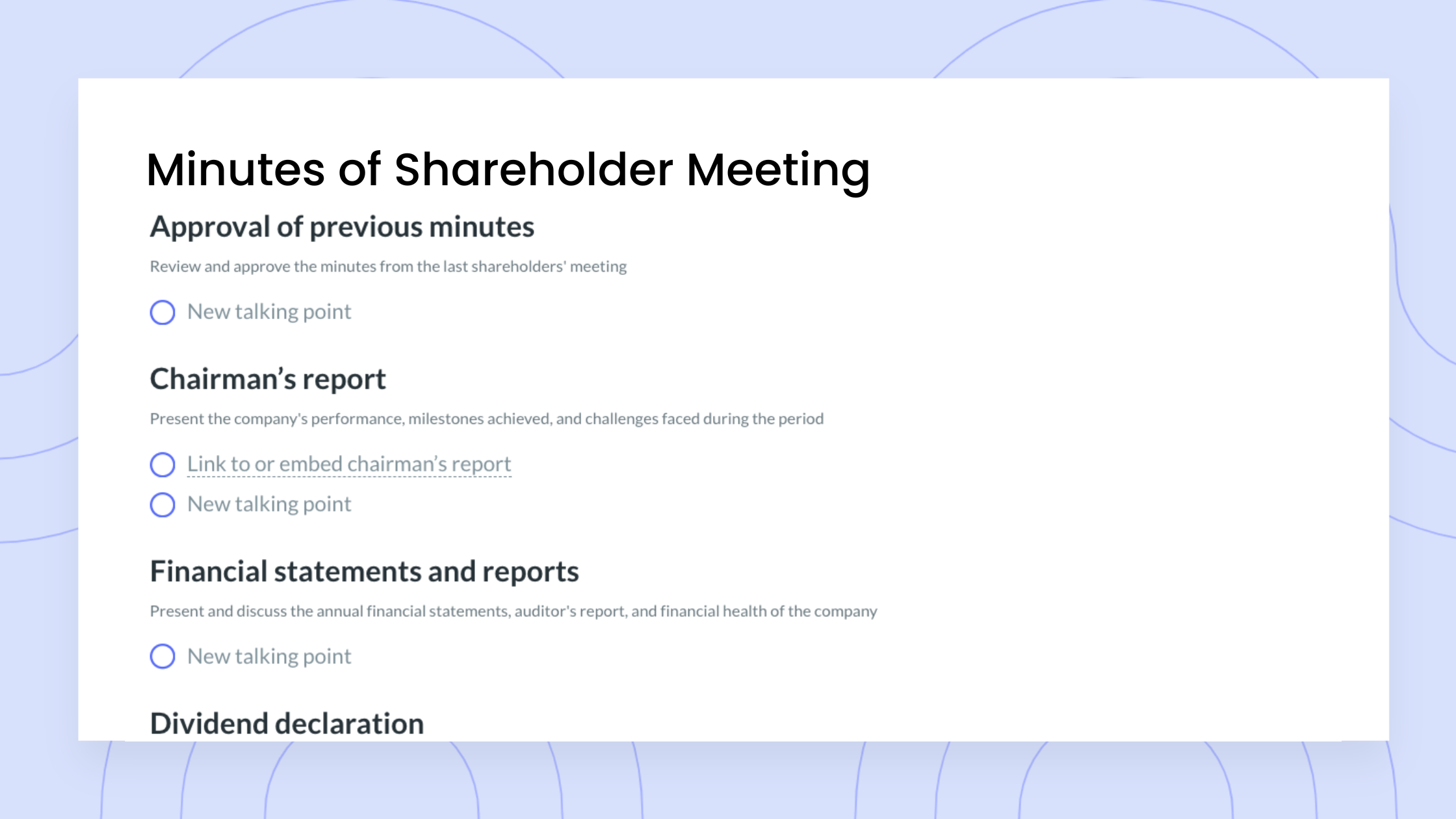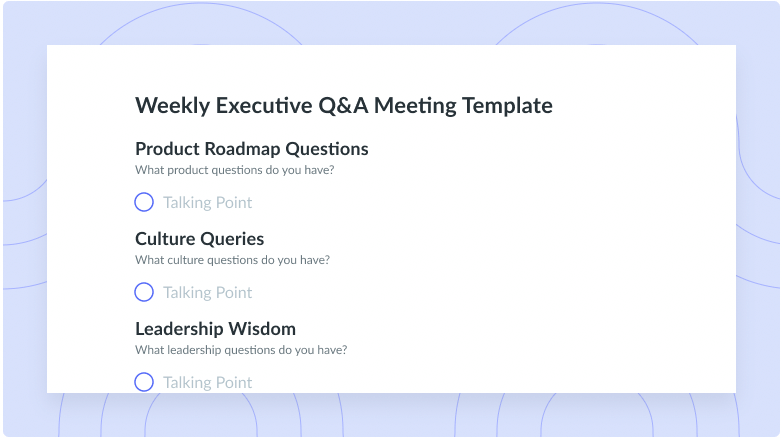Everything You Need to Know About OKRs as a CEO
Learn how to use objectives and key results to improve company processes, manage resources, and improve your decision-making skills.
There are countless benefits to having defined professional and business goals as the head of a company. What if we told you that objectives and key results (OKRs) are one of the best goal-setting methods that you and your executive team can use to turn major objectives into actionable results?
OKRs are used by teams and individuals to set ambitious, meaningful goals with measurable results. Objectives are the overall outcome that you’re striving to achieve. For example, your objective may be to position your company as a thought leader in your industry. Key results are the specific items that benchmark and monitor how you will reach the objective. The best key results are specific and time-bound.
Let’s explore common challenges for chief executive officers (CEOs), outline why CEOs can benefit from implementing OKRs, and look at some examples of OKRs that you can use to implement a system of success.
- Common challenges for CEOs
- Why do CEOs need OKRs?
- Examples of OKRs for CEOs
- Bonus: How to set and track OKRs in Fellow
- Free OKR templates
Common challenges for CEOs
As CEO, you work hard to run your organization effectively. However, the job doesn’t come without its challenges. Internal and external factors may generate concerns, regardless of the industry.
Here are some of the most common challenges that CEOs face in our current business climate:
- Hiring top talent
- Staying ahead of the competition
- Creating a psychologically safe environment
- Communicating change
1Hiring top talent
Every company needs to be able to attract good people in order to achieve the best results. Attracting and retaining quality talent is challenging for a few reasons. Depending on the year, there may be an abundance of high-paying jobs and competition over the best candidates. An employer’s bad reputation may dissuade top-tier talent from applying for new positions. There could be a shortage of skills or a shift in employee needs that your company or industry isn’t prepared to accommodate.
2Staying ahead of the competition
Remaining competitive in a crowded marketplace is another common problem. Companies with outdated systems and processes (hiring included) are much less attractive to top candidates who want to work in efficient environments. If you find yourself competing with similar companies, try differentiating your business proposition. Determine what makes your business better than the rest and lean on your strengths.
3Creating a psychologically safe environment
Psychological safety is the belief that you won’t be punished or humiliated for speaking up about your ideas and concerns. Psychological safety is important because research shows that a company culture with a high sense of belonging leads to over a 50% increase in productivity. Nurturing a safe company culture from the top of an organization can be a challenge when there isn’t buy-in from all leaders in a fast-growing company. For this reason, the importance of psychological safety should be reinforced through regular company training.
4Communicating change
Navigating change is difficult, but leading change through effective communication might be harder. Many CEOs like you may struggle to build trust with teams within the company. As you work to make your business great, you need to remember to create avenues for open communication. You can begin by using simple, straightforward language in your communication with employees, and by being upfront about changes as they happen. Establishing a two-way communication strategy where employees can ask questions, express concerns, and get answers is another option.

Track objectives as part of your meeting workflow
Maximize team success with Fellow’s Objectives tool. Record, track, and review OKRs during meetings for clear goals and aligned priorities. Try Fellow today!
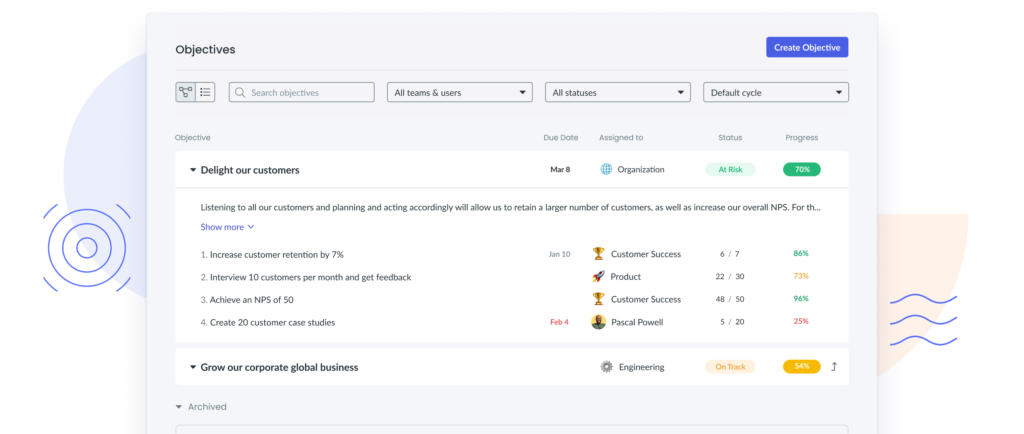
Why do CEOs need OKRs?
There are four key benefits to implementing OKRs in your work as a CEO:
1Improves the delegation process
Think of delegation as the process of empowering your employees to act. OKRs make the delegation process easy by helping you define clear expectations and a process for tasks and projects from the beginning. Distributing work to teams and individual project contributors will free up your time so you can concentrate on leading the company. When implemented properly, the OKR methodology can provide teams throughout an organization the opportunity to contribute to overall business success.
2Boosts focus
Having a list of OKRs will help you and your colleagues focus on your priorities. When you know your goals and the individual steps you need to take to achieve them, it’s easy to drive yourself toward the finish line. With OKRs, every task you work on directly contributes to your objectives, pushing you to focus on valuable work. When you work on a single task at a time, you’ll be able to complete your work more efficiently.
3Fosters accountability
It’s hard to take ownership when you aren’t held accountable for your goals. OKRs foster accountability by providing specific action items with a timeline that you can use to motivate yourself and others. Each key result you check off is a step closer to reaching your objective. You can use this fact as motivation to commit yourself to completing everyday, mundane tasks you might have otherwise put on the back burner. For example, if your objective is to increase the profitability of your company and completing your budget planning and implementation by Q2 is a key result, you may feel motivated to review the financial documents your chief operating officer sent along last week.
4Increases alignment
If you want everyone in your company to be aligned, communicate about your OKRs and encourage teams, departments, and individuals to develop their own. Common goals allow employees to recognize themselves as one piece of the workplace puzzle. When employees are informed of your top priorities each quarter, you help bridge the gap between executives and execution by creating an opportunity for more collaboration and fewer silos.
Examples of OKRs for CEOs
Let’s take a look at five examples of OKRs that CEOs like you can use to set their vision and direction for the company.
1Company profitability
Profitability impacts whether your company can attract investors, fund its operations, and grow. If you sell a product or service and want to increase profits this year, consider creating an OKR regarding your company’s profitability.
Objective: Increase profitability in Q1
Key result #1: Increase the company average deal size by 30% by Q3
Key result #2: Increase sales conversion rate from 25% to 50% by Q2
2Employee engagement
An engaged workforce is a productive one. A high employee engagement rate will create a healthy work culture, reduce staff turnover, and can even positively impact company profits.
Objective: Increase employee engagement and retention across the organization
Key result #1: Create and implement a comprehensive diversity and inclusion policy by Q2
Key result #2: Host 10 town hall format meetings with employees in Q1
3Top-line growth
If you’re hoping to increase revenue generated through your total sales of products and services, consider targeting your top-line growth through OKR methodology.
Objective: Increase employee engagement and retention across the organization
Key result #1: Increase product offerings to region X by June 2025
Key result #2: Achieve two million online orders of product X by the end of Q2
4Market presence
Market presence is your company’s ability to communicate with and reach target consumers. It’s a key indicator of market competitiveness and can help you identify trends in consumer behavior to evaluate your product’s market potential.
Objective: Expand market presence in eastern Europe
Key result #1: Increase the distribution channel to X by Q4
Key result #2: Generate $1 million in sales in the new market by Q3
5Digital presence
Your company’s digital presence will help you build relationships with consumers. It’s your company’s online voice that you can use to generate new customers, retain existing ones, and increase brand awareness.
Objective: Grow the company’s overall online presence
Key result #1: Increase the number of Instagram followers on the company account from 500,000 to 750,000 by 2024
Key result #2: Increase new visitor conversion rate on the website from 50% to 60% by Q2
Bonus: How to set and track OKRs in Fellow
Fellow makes it easy to track objectives as part of your meeting workflow. You can use our platform to stay on top of company goals by tracking the progress of your chosen OKRs in Fellow’s Objectives tool. With Fellow, you can:
- Easily review OKRs during meetings: With the Objectives tab, you can link your objectives with a team meeting for easy access.
- Simplify goal setting: Create new objectives, specify key results, track progress, and update contributors with public and private OKRs in the My Objectives section.
- Provide context and transparency on goals: Improve overall workplace happiness and engagement with Fellow’s Objectives section. You can create departmental goals or increase executive transparency by marking your own as public.
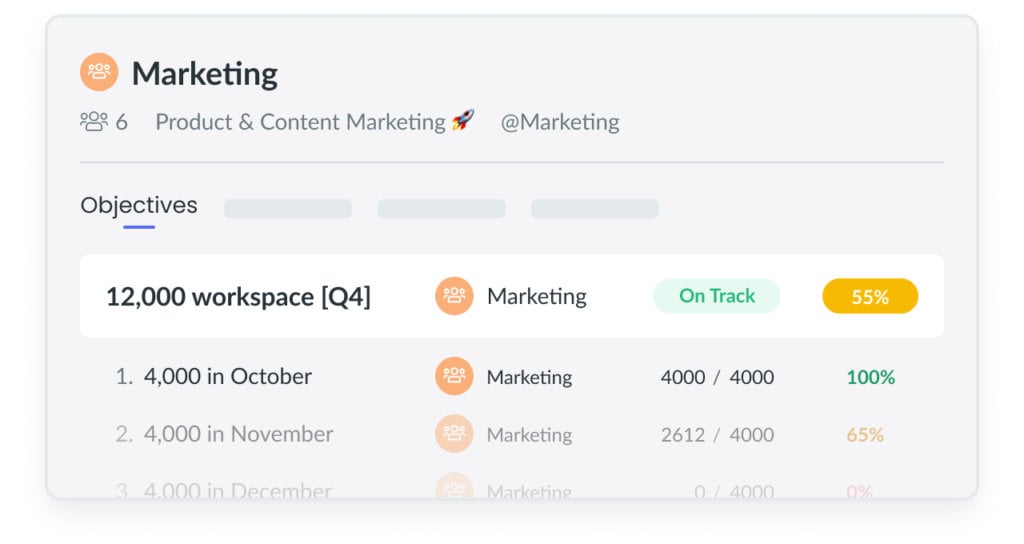
Free OKR templates
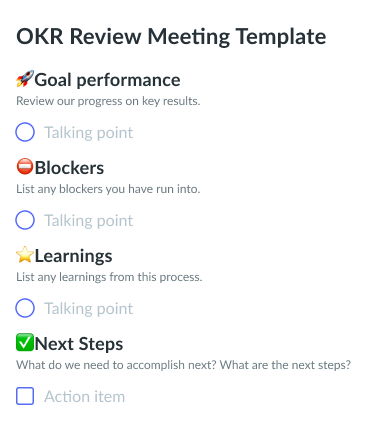


Parting advice
Not sure where to start? OKRs provide a straightforward system to achieve large goals. They can also challenge you to focus on micro tasks and build better habits throughout the process.
Lead your company to success by creating an actionable plan that will encourage you and your employees to reach new heights.
![Everything You Need to Know About Sales OKRs [+ Examples]](https://fellow.app/wp-content/uploads/2022/05/sales-okrs.jpg)
![Everything You Need to Know About Customer Success OKRs [+ Examples]](https://fellow.app/wp-content/uploads/2022/06/cs-okrs.jpg)

![Everything You Need to Know About Engineering OKRs [+ Examples]](https://fellow.app/wp-content/uploads/2022/06/Engineering-OKR.jpg)





